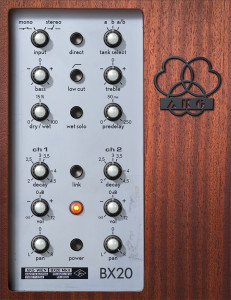New Plugin Review: AKG BX 20 Spring Reverb by UAD
Many great reverb plugins have come out in recent years. A few of my favorites include Universal Audio’s EMT plates and Lexicon 224, along with the more affordable Valhalla reverbs. While we could endlessly debate which plugins should make a “who’s who” list of recent reverbs, I think that most lists would have the following in common: Rooms and plates would far outnumber springs—if a spring even appeared at all.
While all reverbs model sound moving around in a physical space, spring reverbs are particularly complicated because the sound is not the only thing moving—the spring moves too. Rooms and plates (more or less) stay still while sound is bouncing off of them, and by comparison, a spring moves around quite a bit.
This means that springs are more unpredictable, making them very hard to model, and resulting in many engineers feeling let down by the spring emulations available to date.
Universal Audio’s AKG BX-20 is the first emulation I’ve come across to not only sound like an actual spring, but to feel like an actual spring—and a big one at that. It is dark and warm and massive. It captures the feel of an AKG spring in its all-enveloping glory.
Features and Use
The BX 20’s layout looks exactly like the hardware’s, and includes all the features the hardware does: mono/stereo switches, a mix knob, high/low boost or cut, low rolloff, and the expected decay time and predelay controls. You can use tank “A” or “B”, or both, and can control the parameters of each tank independently when they are both activated.
Tank A has a very different personality than tank B. Tank A is considerably darker and excites lower frequencies more, while tank B provides more of a shimmer. Different moments of a given performance would step into the spotlight with each tank.
These are not just two channels of the same spring with a different EQ slapped on—they are entirely different lenses to look at a performance through. It’s really a two-for-one spring reverb emulation plugin.
When your feed a mono source into both tanks, and hard pan the tanks to each side, it creates an ultra-wide stereo spread that maintains interest from left to right. It’s not just a bigger ambience, but a more complicated and compelling one. When this is not desired, UAD has also added the option to use just one of the tanks in stereo, which was not possible with the hardware but a welcome addition for those times when a more balanced and unobtrusive stereo image is needed.
I applaud UAD for adding this feature to the interface’s controls, and it is something that I wish they would do more often. Sometime, UAD’s justified loyalty to the sound of hardware classics results in an unjustified loyalty to the original hardware’s controls. But not here.
We all want the best sound we can get, but why not add things like volume normalizition switches and mix controls to emulations of hardware that couldn’t integrate these now-ubiquitous functions?. In my view, this addition is strictly a positive, and the X-20’s single-tank stereo option is a great example of UAD continuing to shed the negative aspects of perfect emulation.
Summing it Up
This emulation sounds very close to the original AKG springs. While I think that many seasoned spring users would be able to pick it out if they AB’d it with the real thing in solo, I don’t think they would be able to in a mix. And for me, that means the differences are negligible.
In typical UAD fashion, the AKG BX 20 is both fantastic, and fairly expensive for a niche, single-function plugin. While cheaper options like the Valhalla reverbs can stand up to many of the UAD reverb emulations, I don’t think there is a spring emulation out there right now that is anywhere near close to this one. Though the price difference between UAD and some of the smaller developers may be significant, in this case, the quality difference is significant as well.
Please note: When you buy products through links on this page, we may earn an affiliate commission.







